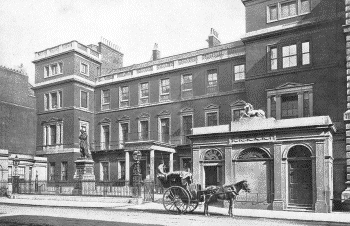York House, Pall Mall on:
[Wikipedia]
[Google]
[Amazon]
 Cumberland House was a mansion on the south side of Pall Mall in
Cumberland House was a mansion on the south side of Pall Mall in
Cumberland House history
- from The Survey of London and British History Online
Cumberland House facade in 1814
(middle of Pall Mall south side)
Cumberland House facade in 1907Cumberland House interiors in 1907
{{Royal palaces in the United Kingdom Former houses in the City of Westminster Royal buildings in London National government buildings in London Royal residences in the United Kingdom War Office Georgian architecture in London
 Cumberland House was a mansion on the south side of Pall Mall in
Cumberland House was a mansion on the south side of Pall Mall in London
London is the capital and largest city of England and the United Kingdom, with a population of just under 9 million. It stands on the River Thames in south-east England at the head of a estuary down to the North Sea, and has been a majo ...
, England
England is a country that is part of the United Kingdom. It shares land borders with Wales to its west and Scotland to its north. The Irish Sea lies northwest and the Celtic Sea to the southwest. It is separated from continental Europe b ...
. It was built in the 1760s by Matthew Brettingham
Matthew Brettingham (1699 – 19 August 1769), sometimes called Matthew Brettingham the Elder, was an 18th-century Englishman who rose from humble origins to supervise the construction of Holkham Hall, and become one of the country's best-known ...
for Prince Edward, Duke of York and Albany and was originally called York House. The Duke of York died in 1767 aged just twenty eight and the house was taken over by Prince Henry, Duke of Cumberland and Strathearn
Prince Henry, Duke of Cumberland and Strathearn (Henry Frederick;He is called simply "(His Royal Highness) Prince Henry" in the ''London Gazette'8 September 1761Palladian
Palladian architecture is a European architectural style derived from the work of the Venetian architect Andrea Palladio (1508–1580). What is today recognised as Palladian architecture evolved from his concepts of symmetry, perspective and ...
style. It was seven bays wide with three main storeys plus basement and attics and was built of brick with stone dressings. The Duke of Cumberland made various alterations. He built a projecting west wing on the site of a neighbouring house that he purchased and added a pair of lodges flanking the forecourt, probably all to designs by Robert Adam. Adam also made many designs for remodelling the interiors, which are now in the collection at the Sir John Soane's Museum, but only a few of them were carried out.
The Duke of Cumberland died in 1790, and in 1800, the widowed Duchess surrendered it to the banks who held mortgages on it.
The house was sold to the Union Club in 1801 and in 1806 it was purchased by the Board of Ordnance
The Board of Ordnance was a British government body. Established in the Tudor period, it had its headquarters in the Tower of London. Its primary responsibilities were 'to act as custodian of the lands, depots and forts required for the defence ...
. From 1858 it housed the War Office
The War Office was a department of the British Government responsible for the administration of the British Army between 1857 and 1964, when its functions were transferred to the new Ministry of Defence (MoD). This article contains text from ...
; a statue of Sidney Herbert was placed in the front courtyard in 1867. An eastern counterpart to the west wing was added in 1809. Cumberland House was used by the government for just over a hundred years. The War Office also acquired several neighbouring houses, including Schomberg House
Schomberg House at 80–82 Pall Mall is a prominent house on the south side of Pall Mall in central London which has a colourful history. Only the street facade survives today. It was built for The 3rd Duke of Schomberg, a Huguenot general i ...
, and knocked them together to form a large office complex. Cumberland House was demolished in stages between 1908 and 1911. The site is now occupied by the Royal Automobile Club.
See also
* List of demolished buildings and structures in LondonReferences
Notes
*''London's Mansions'' by David Pearce, (1986)External links
Cumberland House history
- from The Survey of London and British History Online
Cumberland House facade in 1814
(middle of Pall Mall south side)
Cumberland House facade in 1907
{{Royal palaces in the United Kingdom Former houses in the City of Westminster Royal buildings in London National government buildings in London Royal residences in the United Kingdom War Office Georgian architecture in London